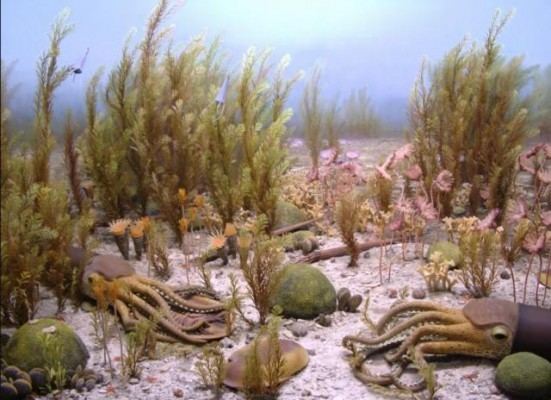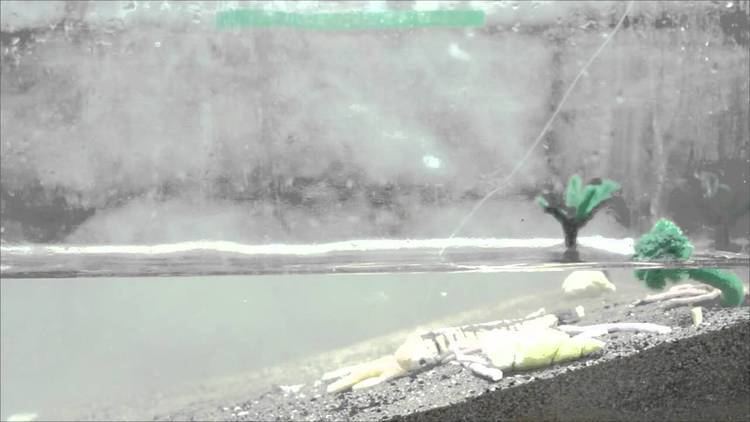 | ||
The Ordovician–Silurian extinction events, when combined, are the second-largest of the five major extinction events in Earth's history in terms of percentage of genera that became extinct. This event greatly affected marine communities, which caused the disappearance of one third of all brachiopod and bryozoan families, as well as numerous groups of conodonts, trilobites, and graptolites. Ordovician-Silurian extinction occurred during the Hirnantian Age of the Ordovician Period and the subsequent Rhuddanian Age of the Silurian period. The last event is dated in the interval of 455– 430 Ma ago, i.e., lasting from the Middle Ordovician to Early Silurian, thus including the extinction period. This event was the first of the big five Phanerozoic events and was the first to significantly affect animal-based communities.
Contents
- Impact
- Possible causes
- Glaciation
- Gamma ray burst hypothesis
- Volcanism and weathering
- Metal poisoning
- End of the event
- References

Almost all major taxonomic groups were affected during this Extinction event. Extinction was global during this period, eliminating 49-60% of marine genera and nearly 85% of marine species.

brachiopods, bivalves, echinoderms, bryozoans and corals were particularly affected. Prior to the late Ordovician cooling, temperatures were relatively warm and it is the suddenness of the climate changes and the elimination of habitats due to sea-level fall that are believed to have precipitated the extinctions. The falling sea level disrupted or eliminated habitats along the continental shelves. Evidence for the Glaciation was found through deposits in the Sahara Desert. A combination of lowering of sea level and glacially driven cooling were likely driving agents for the Ordovician mass extinction.

Impact

The extinction occurred 443.8 million years ago, during the Great Ordovician Biodiversification Event. It marks the boundary between the Ordovician and following Silurian period. During this extinction event there were several marked changes in biologically responsive carbon and oxygen isotopes. The spread of anoxia (the absence of oxygen) greatly affected the organisms that lived in this time period. This complexity may indicate several distinct closely spaced events, or particular phases within one event.

At the time, most complex multicellular organisms lived in the sea, and around 100 marine families became extinct, covering about 49% of faunal genera (a more reliable estimate than species). The brachiopods and bryozoans were decimated, along with many of the trilobite, conodont and graptolite families.

Statistical analysis of marine losses at this time suggests that the decrease in diversity was mainly caused by a sharp increase in extinctions, rather than a decrease in speciation. Several groups of marine organisms with a planktonic lifestyle more exposed to UV radiation than groups that lived in the benthos suffered severely during the late Ordovician. Organisms that dwelled in the plankton were affected before benthic organisms during the mass extinction, and species dwelling in shallow water were more likely to become extinct than species dwelling in deep water.
Possible causes

The analysis of the available information reveals that the conditions during the mass extinction at the Ordovician–Silurian transition were considerably different as compared with the environments during the other four Phanerozoic mass extinction events, although all the main factors that were responsible for these processes were the same: the sea level and climate fluctuations, impact events, and volcanism, which should yield ejection of harmful gases, ashes, and aerosols into the atmosphere and, thus, provoke the greenhouse effect, atmosphere darkening, reduction of the photosynthesis and bio-productivity, the destruction of food chains, and anoxia.
Glaciation

Two environmental changes associated with the glaciation were responsible for much of the Late Ordovician extinction. First, the cooling global climate was probably especially detrimental because the biota was adapted to an intense greenhouse. Second, sea level decline, caused by sequestering of water in the ice cap, drained the vast epicontinental seaways and eliminated the habitat of many endemic communities.
The pulses appear to correspond to the beginning and end of the most severe ice age of the Phanerozoic, which marked the end of a longer cooling trend in the Hirnantian faunal stage towards the end of the Ordovician, which had more typically experienced greenhouse conditions.
As the southern supercontinent Gondwana drifted over the South Pole, ice caps formed on it. The strata have been detected in late Ordovician rock strata of North Africa and then-adjacent northeastern South America, which were south-polar locations at the time. Glaciation locks up water from the world-ocean, and the interglacials free it, causing sea levels repeatedly to drop and rise; the vast shallow intra-continental Ordovician seas withdrew, which eliminated many ecological niches, then returned, carrying diminished founder populations lacking many whole families of organisms. Then they withdrew again with the next pulse of glaciation, eliminating biological diversity at each change (Emiliani 1992 p. 491). In the North African strata, Julien Moreau reported five pulses of glaciation from seismic sections.
This incurred a shift in the location of bottom-water formation, shifting from low latitudes, characteristic of greenhouse conditions, to high latitudes, characteristic of icehouse conditions, which was accompanied by increased deep-ocean currents and oxygenation of the bottom-water. An opportunistic fauna briefly thrived there, before anoxic conditions returned. The breakdown in the oceanic circulation patterns brought up nutrients from the abyssal waters. Surviving species were those that coped with the changed conditions and filled the ecological niches left by the extinctions.
Gamma ray burst hypothesis
Some scientists have suggested that the initial extinctions could have been caused by a gamma ray burst originating from a hypernova within 6,000 light years of Earth (in a nearby arm of the Milky Way galaxy). A ten-second burst would have stripped the Earth's atmosphere of half of its ozone almost immediately, exposing surface-dwelling organisms, including those responsible for planetary photosynthesis, to high levels of ultraviolet radiation. Although the hypothesis is consistent with patterns at the onset of extinction, there is no unambiguous evidence that such a nearby gamma ray burst ever happened.
Volcanism and weathering
The Late Ordovician glaciation event was preceded by a fall in atmospheric carbon dioxide (from 7000 ppm to 4400 ppm). The dip is correlated with a burst of volcanic activity that deposited new silicate rocks, which draw CO2 out of the air as they erode. A major role of CO2 is implied by a 2009 paper. Atmospheric and oceanic CO2 levels may have fluctuated with the growth and decay of Gondwanan glaciation. Through the Late Ordovician outgassing from major volcanism was balanced by heavy weathering of the uplifting Appalachian Mountains, which sequestered CO2. In the Hirnantian Stage the volcanism ceased, and the continued weathering caused a significant and rapid draw down of CO2. This coincides with the rapid and short ice age.
Metal poisoning
Toxic metals on the ocean floor may have dissolved into the water when the oceans' oxygen was depleted. An increase in available nutrients in the oceans may have been a factor. The toxic metals may have killed life forms in lower trophic levels of the food chain, causing a decline in population, and subsequently resulting in starvation for the dependent higher feeding life forms in the chain.
End of the event
The end of the second event occurred when melting glaciers caused the sea level to rise and stabilize once more. The rebound of life's diversity with the sustained re-flooding of continental shelves at the onset of the Silurian saw increased biodiversity within the surviving orders.
Following such a major loss of diversity, Silurian communities were initially less complex and broader niched. Highly endemic faunas, which characterized the Late Ordovician, were replaced by faunas that were amongst the most cosmopolitan in the Phanerozoic, biogeographic patterns that persisted throughout most of the Silurian.
These end Ordovician-Silurian events had nothing like the long-term impact of the end Permian and end Cretaceous extinctions. Nevertheless, a large number of taxa disappeared from the Earth over a short time interval, eliminating and changing diversity on the planet earth.
